By Flint Whitlock
It was early in 1945 when the Battle of Po Valley officially began: from their hiding places in the valley below, the soldiers looked up at the wall of shale looming more than 3,000 feet above them. The ridge was nearly denuded; most of the vegetation on its steep slopes had already been chopped down for firewood by the starving Italian people in the villages scattered along the banks of the Dardagna River—a rocky, swiftly moving stream at the base of the cliff.
Germans Await Allies At Ridge Summit Of Treacherous Ridge
The soldiers studied the rock face for a very long time, speaking quietly as they scanned the shale with binoculars and jotting notes onto a map of the area. The map named this series of connected peaks Monte Della Riva. The troops simply called it Riva Ridge. They could see places on the ridge that looked fairly easy to navigate, and other parts of the trail that offered more of a challenge—places where snow and ice clung to shadowy crevasses, places where small waterfalls cascaded over rock, places where the shale looked loose and easily broken. What they could not see but knew was there was an alert German battalion on the summit, just waiting for the Allies to make another foolhardy attempt on the neighboring mountain, Monte Belvedere.
Ordinary soldiers might have been daunted by the geological feature rising in front of them. But these were not ordinary soldiers. These were members of an elite outfit called the 10th Mountain Division—the only American division specially trained for mountain and winter warfare. And they had been hoping, praying, and hungering for four years for just this opportunity. The young men reconnoitering Riva Ridge this cloudy February morning were smiling. Their eyes gleamed with the excitement of young boys who had found some secret treasure. They were figuratively licking their chops because, at last, they finally would be able to prove themselves in combat. They had a thirst for battle because they had not yet tasted its bitterness. (Read more about the exploits of the 10th Mountain Division and the fighting in Europe inside WWII History magazine.)
A Litany Of Italian Towns Brings Woe To American Forces
The 10th Mountain Division thus far had been spared the brutal mountain fighting that had begun to take its toll on Allied forces in Italy almost immediately after the landings in the Gulf of Salerno on September 9, 1943. The 10th had not had to endure the agony of the winter fighting around Venafro; had not been forced to attempt the ascent to Monte Cassino; had not been torn to shreds trying to cross the Rapido River. The names of Italian towns and mountains where terrible battles had been fought—San Pietro Infine, Castel del Rio, Mignano Gap, Futa Pass, Livergnano Escarpment, Monte Lungo, Monte la Difensa, Monte Maggiore, Monte Summucro—were simply words the soldiers had read in Yank or The Stars and Stripes, and held no special meaning, no special nightmares.
General Dwight D. Eisenhower, the Supreme Allied Commander, had called the division a bunch of “playboys”—and with some justification. No other infantry division had a higher collective I.Q. or a higher percentage of high school and college graduates in its ranks. Many of the mountain soldiers had been hotshot skiers from East Coast prep schools and Ivy League colleges. Many of the sergeants, such as Walter Prager, had been college ski coaches, instructors at resorts such as Sun Valley, or members of their college ski teams. Quite a number were foreign-born, world-class skiers and mountaineers from Norway, Switzerland, even Austria. One was a member of the von Trapp family, immortalized by the 1965 film, The Sound of Music. They were cocky, arrogant, and brimming with self-confidence. Their commanding general, George P. Hays, had even won the Medal of Honor in World War I and inspired them with stories about the glory of combat. They had trained for two years high in the Colorado Rockies at Camp Hale, where they had been toughened by blizzards, then baked in the broiling heat of a Texas summer at Camp Swift prior to their deployment to Italy. They were as fit and ready and motivated as any unit anywhere.
An Elite Unit With No Takers
The 10th was one of the first units formed at the beginning of the war, and one of the last to be deployed to combat. Because it was so highly specialized, with 75mm howitzers instead of 105mm and 155mm guns, tracked Weasels instead of trucks, and 5,000 pack mules and horses at a time when the Army had all but phased out animals, the 10th found no takers when Army Chief of Staff General George C. Marshall offered it to various theater commanders.
One of its regiments, however, the 87th Mountain Infantry, had been deployed in August 1943 to the Aleutians, where it had splashed ashore at Kiska as part of a 40,000-man invasion force, only to find the occupying Japanese enemy had gone. The deaths and injuries caused by “friendly fire” on the fog-shrouded peaks before it was discovered that the enemy had been evacuated before anyone knew it, while regrettable, simply did not count as being in combat to the men of the 10th.
The Po River Valley: a Bloody Attrition War
But now, in February 1945, they would finally get their chance. Riva Ridge was just one set of peaks in the northern Apennines, some 160 miles north of Rome and 35 miles north of Florence, which guarded the approach to the vital Po River Valley. For 17 long, agonizing months, the Allies had been slowly pushing the Germans north from Salerno in a bloody war of attrition. Since the autumn of 1944, the Allies had been trying to break into the Po Valley but had nothing to show for the effort except mounting casualty lists.
That fall, with the Italian Campaign having taken a backseat to the main thrust across the continent of Europe, reinforcements and replacements were hard to come by. Indeed, General Mark Clark’s Fifth Army seemed to be cobbled together. Besides American units (including the only all-black infantry division, the 92nd), the Fifth had troops from Brazil and South Africa. Fresh blood was needed to break the stalemate in the mountains, and Clark thought that the 10th, despite all its animals, was perfect for the job.
10th Mountain Division Finally Gets the Call
At Thanksgiving 1944, the division, which many at the War Department had wanted disbanded and its troops parceled out as replacements, was finally alerted for overseas movement. By the end of 1944, the division was in Italy and was north to the front, where it was ordered to hold the line between the 92nd Division on its left and the Brazilian Expeditionary Force on its right. Ahead of them were the German 4th (Edelweiss) Mountain Battalion and elements of the 232nd Infantry Division of the 51st Mountain Corps holding snow-covered Riva Ridge, Monte Belvedere, Monte Della Torraccia, and more.
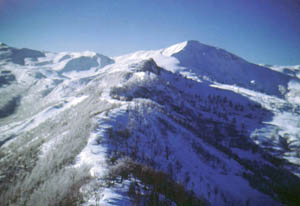 At first, the 10th acclimated itself to the terrain and weather. Patrols on skis and snowshoes probed toward enemy lines. One night, American Olympic ski racer Steve Knowlton was on a ski-mounted patrol when the Americans encountered a German, also on skis. Thinking the Americans were his kameraden, the German nonchalantly waved, only to be greeted by a volley of fire. Turning quickly, the German schussed down the hill only to crash into a grove of trees and break both legs. “The bullets didn’t stop him, but the trees did,” Knowlton remarked.
At first, the 10th acclimated itself to the terrain and weather. Patrols on skis and snowshoes probed toward enemy lines. One night, American Olympic ski racer Steve Knowlton was on a ski-mounted patrol when the Americans encountered a German, also on skis. Thinking the Americans were his kameraden, the German nonchalantly waved, only to be greeted by a volley of fire. Turning quickly, the German schussed down the hill only to crash into a grove of trees and break both legs. “The bullets didn’t stop him, but the trees did,” Knowlton remarked.
Bud Lovett, a medic, recalled an incident on another patrol. “I saw a German on skis standing on a snow dam between two ridges. We ordered him to put his hands on his head. He stood and looked at us, then did a jump turn and skied right down that thing as if it were a headwall. Nobody shot at him; I think most of us were impressed by his skiing.”
Riva Ridge Was The Key To Taking Mountain
During those first few weeks following the 10th’s entry into the line, there was little heavy fighting, only sporadic and desultory exchanges of artillery. But General Hays had not brought his men all this way just to hold a defensive position, and soon a new offensive was in the works, one that would pit the 10th Mountain Division in the valley against the Germans holding the high ground. Hays’ staff officers pointed out that previous attempts to take Monte Belvedere, overlooking Highway 64, had failed because German artillery observers on Riva Ridge could spot any movement toward the mountain and bring deadly accurate fire down upon the attackers. The key to taking Belvedere, they argued, was Riva Ridge. The operation, then, was planned for Riva Ridge to be assaulted and held the night before the main assault climbed Monte Belvedere. But, first, routes to the top of Riva Ridge needed to be found.
It took over a week for the scouts of the 10th to plot the routes, but eventually five trails were mapped out. The thousand-man 1st Battalion of the 86th Mountain Infantry Regiment, augmented by F Company from the 2nd Battalion, was detailed for the mission. D-day for the operation was February 19, 1945. Half a world away, on that very date, U.S. Marines were storming ashore at an island called Iwo Jima.
A Silent Assault Is Launched
On the night of February 18, all was in readiness for the Battle of Po Valley. Hiding in the villages at the base of Riva Ridge were over a thousand anxious Yanks, primed and ready for the operation. At the appointed hour, they moved out, crossed the narrow, swiftly running Dardagno, and began the upward climb. Unlike most assaults, this one was conducted with no preliminary artillery bombardment; there must be nothing to tip off the enemy that an attack was about to be launched. The advance climbing party even wore soft caps so that no helmet would rattle or fall off and clatter down the rocks. Absolute noise discipline was observed; the slightest sound could alert a sentry and bring the firepower of the garrison atop Riva Ridge down upon the attackers.
Aiding the climbers’ ability to see was “artificial moonlight.” From across the valley, searchlight beams were bounced off the heavy cloud cover, and the reflection provided just enough illumination to allow the men of the 10th to find their way to the top. Fortunately, a patchy fog kept any curious Germans from peeking over the top of the ridge to see the attackers coming. Also fortunately, the Germans had posted no sentries below the summit; they were convinced that no one could possibly attack them from the cliff side.
Germans Surprised Before Having Their First Cup Of Coffee
The climb took all night. At dawn, the raiders slipped over the crest of the cliff and caught the Germans napping in their foxholes. “They hadn’t even had their first cup of coffee yet,” commented one mountain trooper. Some of the stunned Germans tried to fight back but were quickly silenced. The off-duty troops, resting in the bunkers on the gentler reverse slope of the ridge, began piling out in various stages of undress, only to be hit by volleys of American fire.
Bart Wolffis of the 86th Regiment’s Company A and two others rushed over the top of the ridge only to hit a patch of ice. “All three of us landed on our butts and started sliding down the German side of the hill. All I could think of was, ‘We’re going to slide right into the Germans.’ We were using our rifle butts to try and stop us from sliding. As it turned out, there was a fairly shallow bowl and we slid to a stop.”
Moments later, Wolffis recalled spotting eight Germans a couple hundred yards away. “They didn’t know we were there until we began to fire at them, and then they ran into a bunker. A couple of them then came out and took up firing positions. Every now and then, a reserve company of Germans would [appear], quite a ways behind where the other ones were that we were firing at. They were across a big snow field, and every time they’d get about halfway across, we’d call for artillery fire and that would break up the counterattack.”
A War Breaks Out Across the Ridge
All across the five-mile-long ridge, war on a small scale was waged, with the five companies of Americans, who now held the higher ground, raking the counterattacking Germans with all manner of rifle and automatic fire, grenades, mortars, and artillery. So complete was the surprise that very few of the 10th Mountain men were hit, but the battle was costly for the defenders.
Nowhere was the fighting more intense than on the far eastern spur of the ridge known as Pizzo di Campiano. Here, Lieutenant James Loose and a dozen of his men from Company A of the 86th became separated from the rest of their platoon and encountered two enemy companies—a much larger force than intelligence had estimated was there. At 0500 hours, the battle for the spur began. The Yanks were hit by a flurry of grenades, then attacked several times, each time fighting off the attacks with their dwindling supply of ammunition.
Even though the rest of Riva Ridge had been secured by the 10th in just a few hours, the battle for Pizzo di Campiano lasted all day and through the night; reinforcements could not reach the men. The next day, when at last it appeared that the cut-off, half-starved Americans were about to be overrun, Loose called artillery down on his own position and broke up the attack. The battle continued to rage through the next day until a relief column, led by the battalion commander, finally reached the summit.
Relentless Germans Attack From Same Slope Americans Ascended
After midnight, Loose and his tattered unit finally came off the mountain. Loose, who had only a handful of men wounded, said, “Last thing I told the platoon leader who relieved us was, ‘They’ve attacked us from every direction but one, and that’s the way we came up. And that’s the way they’re going to attack next.’ Those Germans hadn’t given up; they were still at it. They never stopped. Morning, noon, and night, they were still after us. It got awful tiresome. And, lo and behold, next morning, I stood down below and I could see the Germans, climbing up the same slope we had climbed, to attack that platoon from the rear.”
As scheduled, the night of February 19 saw the 10th’s other two regiments—the 85th and 87th, along with the rest of the 86th—move out of their hidden assembly areas and begin the long, slow, and tense climb up Riva Ridge’s neighbors, Monte Belvedere, Monte Gorgolesco, and Monte Della Torraccia. With 95 percent of Riva Ridge now under new management, the Germans who had used the ridge as an observation post were unable to sound the alarm and direct artillery fire upon the attackers.
An Ineffable Sense Of Duty
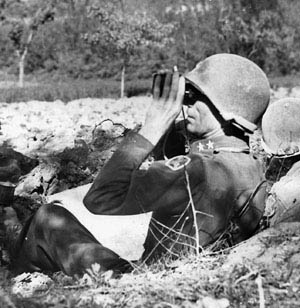 Once again, the assault was not preceded with an artillery barrage. But the Germans, who by now knew that Riva Ridge had fallen, were on full alert. As the mountaineers snipped their way through barbed wire, they triggered mines, which then brought down a torrent of German fire. Parachute flares popped overhead, turning the night into a ghostly day, while tracers tore bright paths through the night sky. Yet, the small clumps of men moving uphill did not waver. These highly disciplined troops did not run away, as ordinary people would. Perhaps it was the months and years of training for just this moment. Perhaps it was the fear of shame at fleeing in the face of undeniable terror and leaving one’s buddies to face the horror alone. Or perhaps it was an ineffable sense of duty. Whatever it was, it kept them going up the hill in the face of an incredible amount of metal being thrown at them by the enemy.
Once again, the assault was not preceded with an artillery barrage. But the Germans, who by now knew that Riva Ridge had fallen, were on full alert. As the mountaineers snipped their way through barbed wire, they triggered mines, which then brought down a torrent of German fire. Parachute flares popped overhead, turning the night into a ghostly day, while tracers tore bright paths through the night sky. Yet, the small clumps of men moving uphill did not waver. These highly disciplined troops did not run away, as ordinary people would. Perhaps it was the months and years of training for just this moment. Perhaps it was the fear of shame at fleeing in the face of undeniable terror and leaving one’s buddies to face the horror alone. Or perhaps it was an ineffable sense of duty. Whatever it was, it kept them going up the hill in the face of an incredible amount of metal being thrown at them by the enemy.
The battle for the Belvedere hill mass went on through the night and into the next day. The fighting was terrific. Marty Daneman, a soldier with Headquarters, 2nd Battalion, 85th Regiment, recalled being caught in a grove of trees during an enemy barrage: “The crescendo of the shellbursts continued. For what seemed like hours, shrapnel, shrieking through the air a few inches over my head, tore gaping holes in the tree trunks, sending them crashing to the ground.”
Germans Knocked From Apennines And; 10th Proves Its Worth
Supported by Sherman tanks of the 751st Tank Battalion, the mountaineers gradually pushed the Germans out of their bunkers and off the heights, only to be on the receiving end of tremendous artillery and mortar barrages and numerous disorganized counterattacks that took place for four days. Despite the bitter fighting and the heavy casualties, the hill mass was finally secured by February 24. The 10th had had its long-sought baptism of fire. Most importantly, the mountaineers had proven themselves and had accomplished their mission; the German grip on the northern Apennines was finally shattered.
In the weeks and months to come, the 10th spearheaded the Fifth Army drive out of the mountains during the Battle of Po Valley. The Germans were now fleeing for the safety of the Alps and doing everything within their power to stall the 10th’s pursuit. But the 10th would not be denied. The mountaineers paddled across the Po while under enemy fire; they were the first American division to cross this river. Up along the shores of Lake Garda, Italy’s largest lake, rolled the 10th, and then across the lake in amphibious DUKWs, where they occupied former Italian dictator Benito Mussolini’s abandoned villa.
Then it was into a series of highway tunnels into which the Germans fired their deadly 88s and tore the Americans apart. Eventually, the 10th reached the towns of Nago and Torbole where, on April 30, 1945, Assistant Division Commander William O. Darby, the founder of the Rangers, was killed by one of the last shells fired during the war in Italy. Two days later, the Germans in Italy surrendered. The war in Europe was almost over.
They Never Lost a Battle, Nor Gave Up an Inch Of Ground
Through no fault of their own, the 10th Mountain Division was a Johnny-come-lately to combat. Yet, the division had performed brilliantly, never losing a battle or giving up an inch of ground. But the cost of victory was high. In only 114 days of combat, the 10th lost nearly 1,000 men killed and over 4,000 wounded.
The division’s contribution to victory during the Battle of Po Valley did not pass unnoticed. Mark Clark wrote, “The 10th Mountain Division, which entered the line only last January, has performed with outstanding skill and strength.” General Hays, the 10th’s commander, told his men, “I am proud indeed that the knockout thrust has been spearheaded by the 10th Mountain Division….When you go home, no one will believe you when you start telling of the spectacular things you have done. There have been more heroic deeds and experiences crammed into these days than I have ever heard of.”
A Fitting Sendoff With a Ski Race At War’s End
The men of the 10th celebrated the end of the war in the one way that seemed uniquely appropriate for them: They organized a ski race. On the crusty summer snows of Mount Mangart, where the borders of Italy, Austria, and Yugoslavia come together, the 10th’s best skiers challenged each other. First Sergeant Walter Prager, the Dartmouth ski team coach, won. It seemed a fitting way not only to end a war, but to begin a new world.
Denver resident Flint Whitlock, son of a 10th Mountain Division veteran, is the coauthor, along with Bob Bishop, of the definitive history of the division, Soldiers On Skis: A Pictorial Memoir of the 10th Mountain Division.
Originally Published July 29, 2015
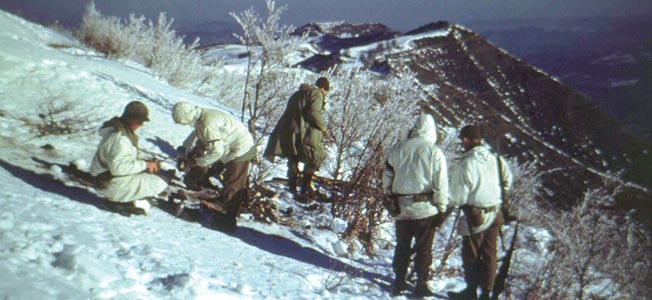
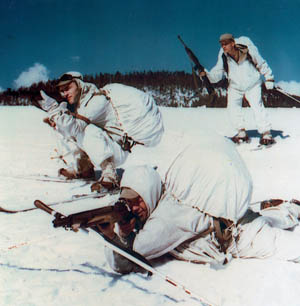
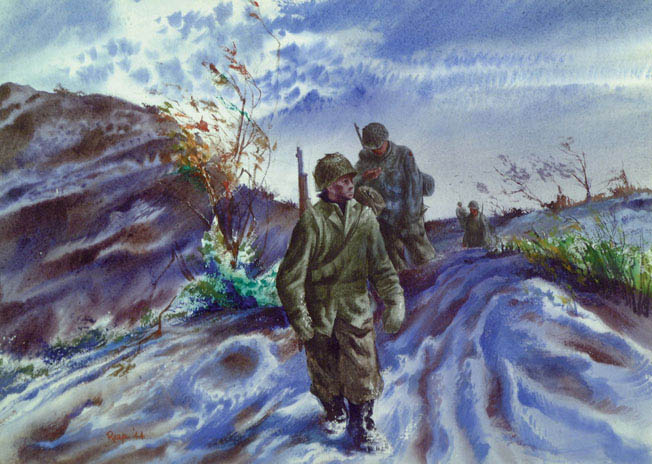
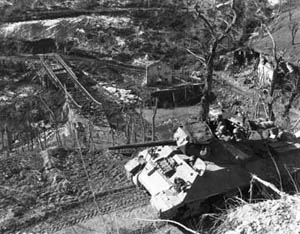
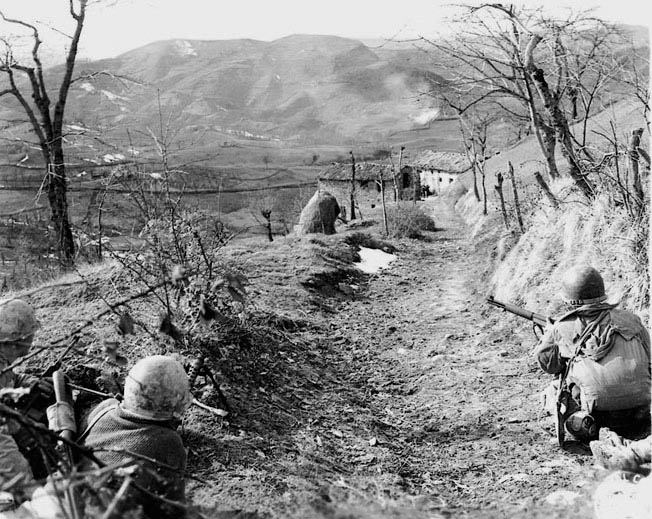
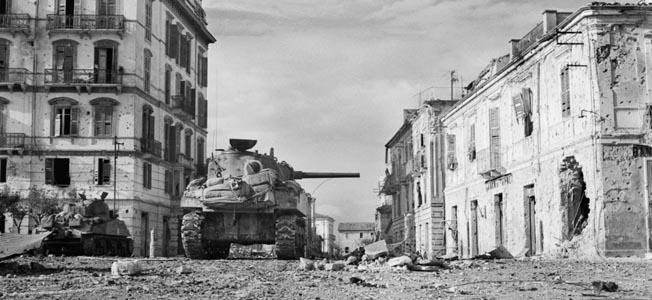
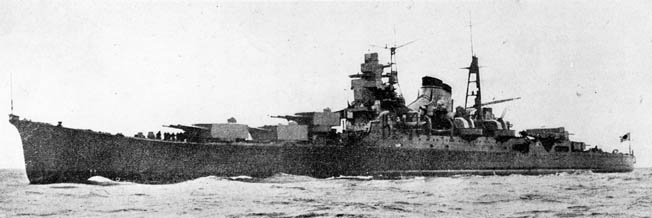
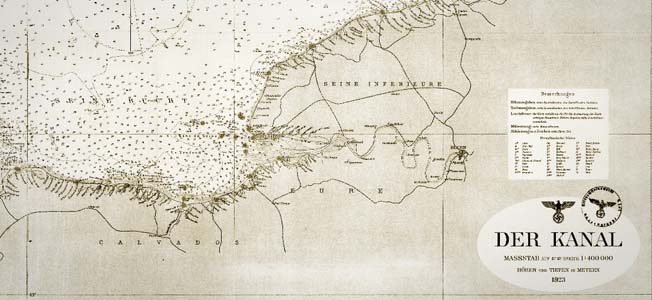
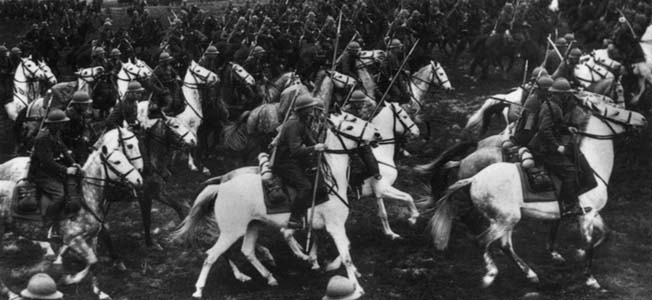
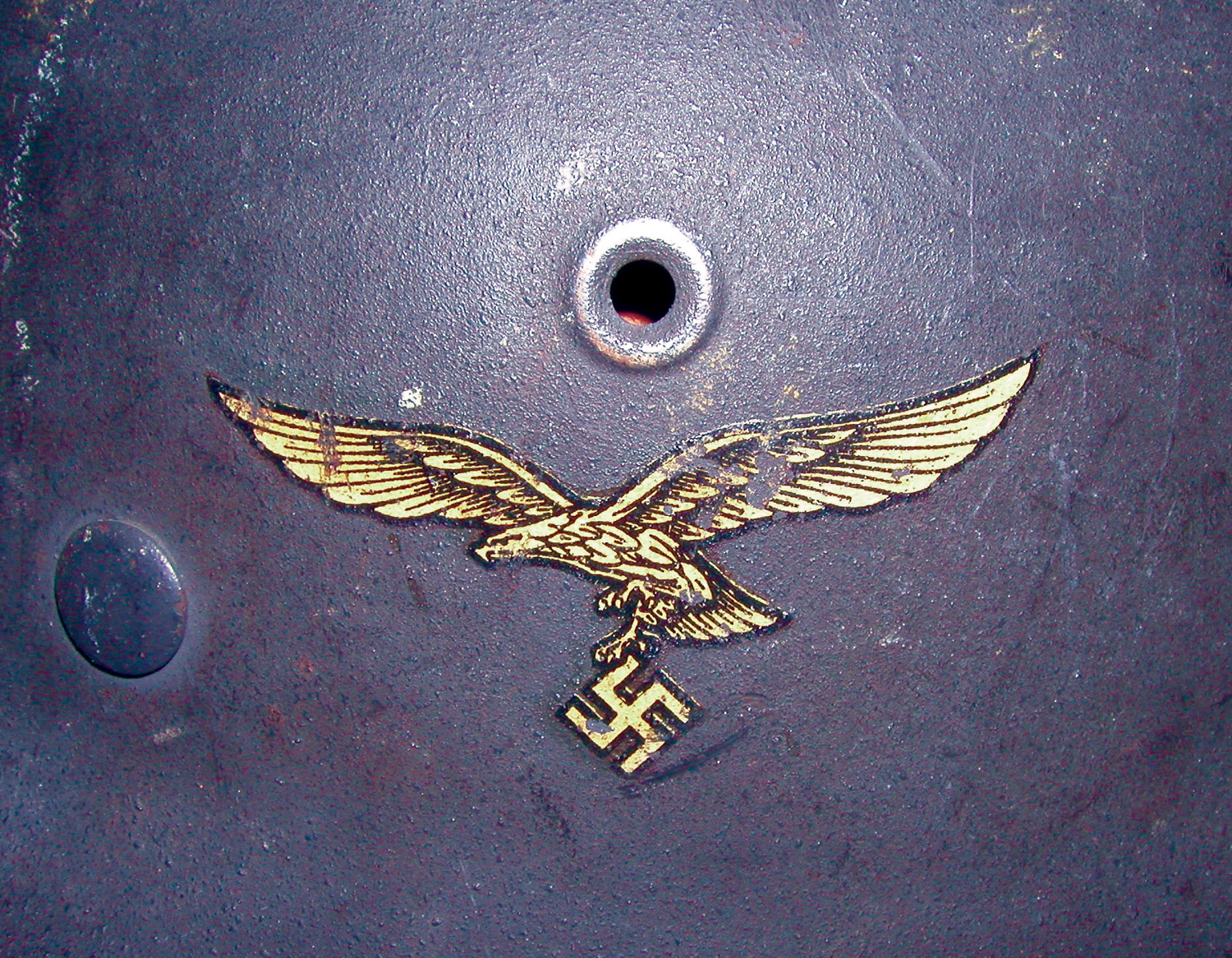
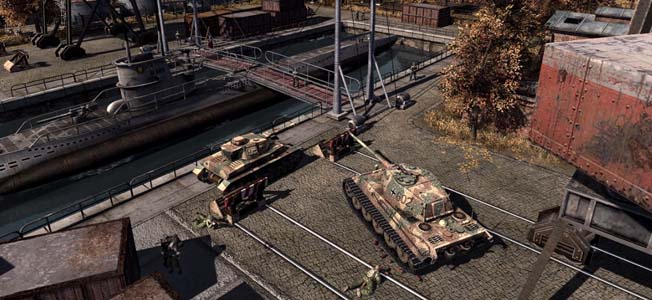
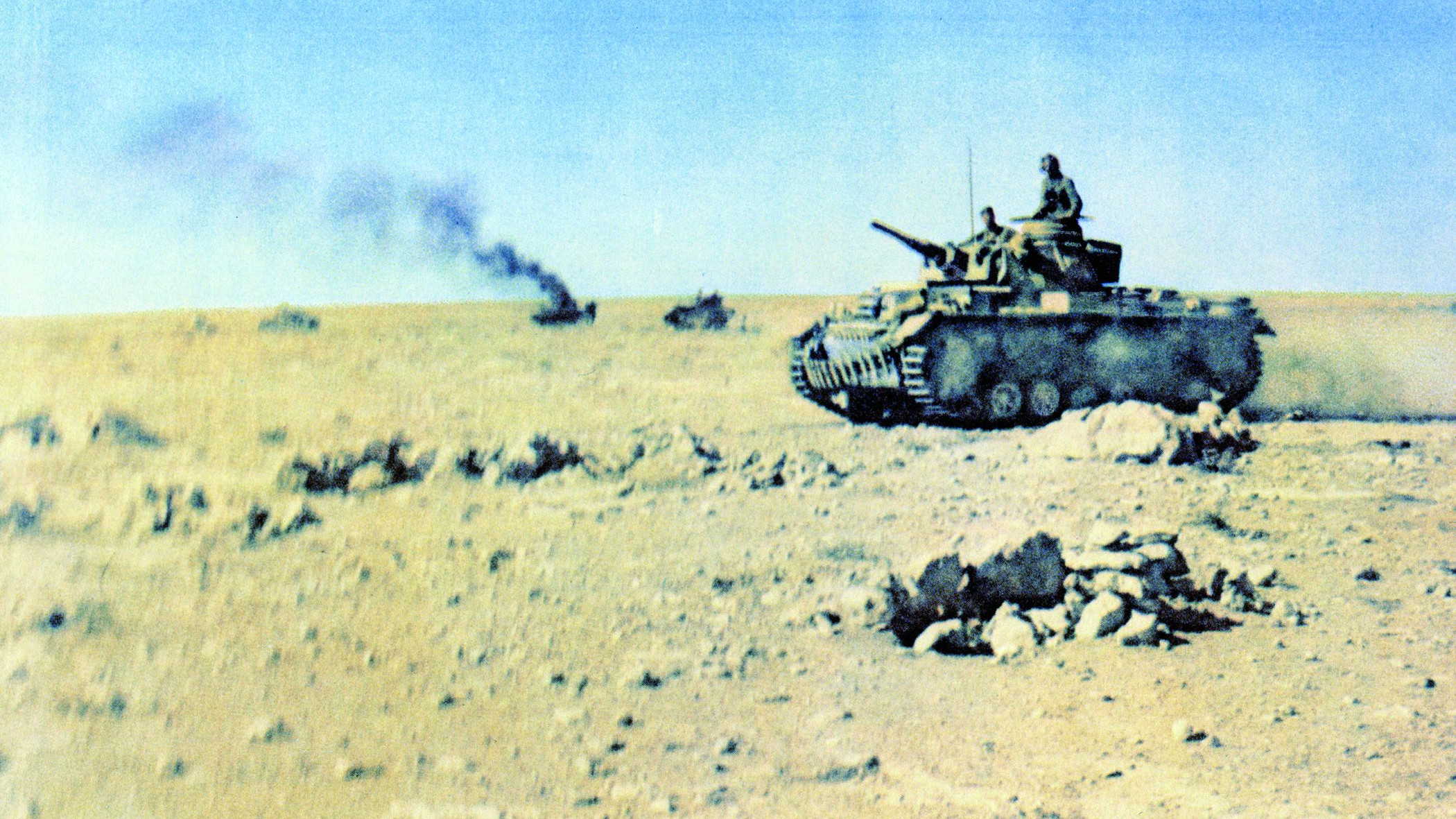
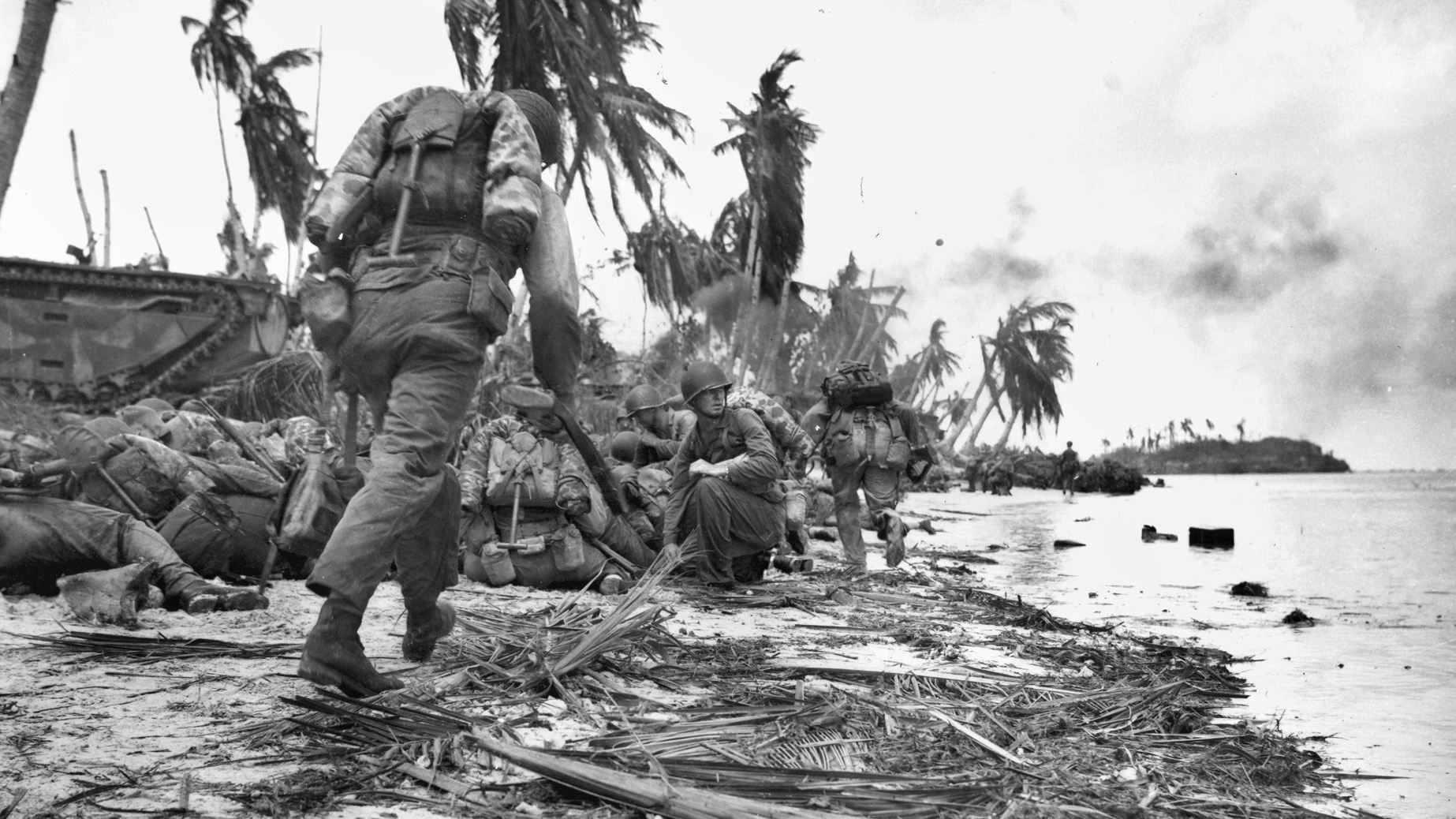
my father ,Leland John Blevins was a member of the original 10th mountain division. He grew up in the foothills of the Adirondack mountains in the town of Hermon NY. Even though he had never skied he was sent to 10th to replace soldiers injured in mountain training in Colorado. He did not talk about the war very much but I remember the Po river valley and the accuracy of German 88’s, and the fact that they were not allowed to stop & help those hit by shrapnel as they marched up the valley. He served as a runner at least part of the time in Italy. He went on to become a farmer in Hermon until a back injury forced him to seek other work which eventually led him to take over a defunct Dodge car dealership in Potsdam,NY, in 1969. He passed away at 82 years old in 2007 after retiring in Wauchula Florida for many years. The family dealership was his pride and joy, today it is run by 2nd ,3rd, & 4th generation Blevins family. Needless to say we are very proud of Dad & his many accomplishments including his service in the 10th mountain division. Paul Blevins, 11399 SE 177th Ln., Summerfield, Fla.
My dad, Willard R. Kniess was in the 87th Mtn. Regiment. I think my dad talked about his experiences not to brag, but to relieve the stress of what he experienced in Italy. The names of those he spoke of, will forever be etched in my mind.The last time I was able to visit my dad in 2003, he was crying. I asked him what was wrong and he was reliving a day when one of his buddies was killed. They were being sniped at and my dad told his buddy to keep his head down. His buddy had to take one more look and a bullet tore through his neck killing him. Dad had several stories of the hell he faced. Dad became a replacement as chief wire man because another buddy told the company commander and first sergeant that if something were to happen to him, my dad would be the best man to take his place. A couple of weeks later the buddy who made the recommendation was killed in action. My dad was awarded the Bronze Star and a Purple Heart for actions taken while under heavy fire in action against the enemy. My dad tackled one of his compatriots who cracked while under enemy fire. As mortar rounds were exploding around him he jumped up and knocked the soldier down. In doing so shrapnel peppered his legs and back. When the fighting eased up he finished his duty of insuring that communications were still working before being ordered to the aid station. He escorted the soldier he tackled also.For years after my mom removed pieces of shrapnel that would infect as it worked itself out of his back and legs.
Dad talked about the Po River crossing. He said that it was frightening because they did it in broad daylight. They were using rifle-butts, boards, and a few paddles provided as they crossed the 1/4 mile span in collapsible canvas boats. Dad said the Germans were using anti-aircraft guns, German 88’s, and heavy machine guns. Men were yelling, praying, and singing 10th Mtn, songs as they paddled for their lives. It was moments such as that made a mark on my dad. I was lucky enough to meet several of the men he served with including his company commander. But it was the men he served with who never came home that we all owe a debt of gratitude for. Those names echo in my heart and mind on Memorial day when I hear taps played. If my dad could shed tears for men 58 years after the guns were silenced, I think that I can share that legacy too.
My dad, James J. Hinkle was in the tenth mountain decision and was awarded the bronze star. After returning home and marrying at 35 he became the father of three girls which may have been the reason he didn’t share stories of his time in the tenth. I gave him his only grandson and he did tell him some of his stories but as often happens it was after he passed away that we began seeking more information from this time. I would be interested in hearing any stories that could be passed on to us.
In the Aleutians, the 10th were in combat against Japanese troops in the Battle of Attu.
My reading says that when the 10th reached Attu the Japanese had already abandoned the island. All the battle was friendly fire, and embarrassing first foray into war.
Thank you to all for this history. My father Windsor J. Borden was 10th Mountain during WWII in Italy. He passed in 1997. He was just beginning to be able to discuss the war when he passed. He was one of the finest humans that has ever been on the planet. I believe the members 10th Mountain Division played a pivotal role in the formation of his character. He was a true gentleman.
Yes thank you for the wonderful history of my division. I’m a proud Mountainman. A Veteran of C Co MTRS 1/87th IN. I was honored to be a member of the US’s first mountain unit, the 1st Battalion 87th Infantry during most of the 1990’s.
The legacy of our forefathers in the 10th who served during WWII ensured the division will forevermore be active.
I went to high school in Boulder, CO, class of 1964. I dated the daughter of Bob Heron, who is famous in Ski Country for engineering ski lifts through his company of the same name. Since I just re-connected with the daughter, I’ve been re-interested in the 10th Mountain Division. Bob Heron was an engineer with the 10th, and built “lifts” out of mining equipment they discovered on Riva Ridge. It was from this WWII battle experience that he saw the future of the ski industry in Rocky Mountains. Bob Heron came to Colorado as did many 10th veterans to pioneer the industry, he built Lift #1 in Aspen back in 1947.
This story by Flint Whitlock is very good. I can visualize the movie from the first sighting of American skiers who dared to arrive in the Alps where only German Eagles roost, to the celebratory ski race to close out the war. Of course it is the skiers that get the attention and credit, but a division is a mighty force of soldiers, truck drivers, artillery, cooks, medics, and a few engineers like Bob Heron. The actual skiers would have been runners, observation, and snipers, doing just a few of the many jobs necessary to fight a war in the mountains.
My grandfather, William J. Sherman Sr., was a Tech Sergeant Medic with Charlie Company, 10th MED. He was awarded the Bronze Star and Purple Heart. He passed away while I was young, and he did not like to talk about his time overseas. I heard stories from other family members about his hunkering down for the night in a building while tending to an injured soldier. I also heard that in addition to learning how to ski, he also learned mountaineering skill such as the Tryolean Traverse to evacuate wounded via a rope strung between two high points. I was lucky enough to follow in his footsteps and serve with the 10th MTN DIV in Iraq in 2005.
Russell S. Gahres volunteered for the 605th Field Artillery Battalion of the 10th Mountain Division, which was activated 11 Jan 43. Since he was an automotive mechanic he most likely didn’t train at Camp Hale, CO in 43-44. The 10th Mountain Division arrived in Italy on 6 Jan 45. From Naples, Italy, the 10th Mountain set sights on routing the Germans from Mount Belvedere. During this the 10th saw action on the Volturno Line and supported the VI CORP Mount Belvedere provided the key to advancement into the Po Valley and securing Mount Belvedere depended on routing German artillery entrenched on Riva Ridge. Russ was assigned to Battery C 605th FA Bn and was in the battle for Po Valley in 5-26 Apr 45. During the start of the Po Valley campaign the 10th Mt Div was assigned to the IV CORP.
Russ left Europe around 10 Jun 45 and was discharged as a Technician Sergeant on 26 Jun 45 from Ft. Dix, NJ. His medals include the Good Conduct Medal; American Defense Service Medal; European-African-Mid East Medal. His campaign participation include Naples-Foggia; North Apennines; Po Valley; Rome-Arno; Sicily and Tunisia.
My Dad Ralph B Bearden was in the 10th Mountain Division during WW2. He received the Bronze Star. A portion of a newspaper article telling what he did follows. “CORPORAL RALPH B. BEARDEN, 27 of Clearwater, recently was awarded the Bronze Star Medal for meritorious service in combat on the Fifth Army front during the Italian Campaign. He is a switchboard operator in a field artillery battalion of the 10th Mountain Division. When his battalion moved forward Bearden remained behind, operating a rear switchboard until a new line could be installed to the new forward position. When relieved, he moved to another area, establishing another switchboard under the handicap of darkness. Although under enemy artillery fire, he remained at his post servicing all calls during an attack. It was due largely to his efforts that communications remained intact while the battalion pushed on to further the attack.”
Dad only told me one story about his service experience. He said that the division along with their pack mules crossed over the Atlantic on the Queen Mary. After arriving in Italy the cannon fire was so intense that all the mules broke loose and deserted into the mountains. Because of this, Dad being the radio man, now had to carry his own equipment. He carried a 100 pound pack into the Italian Alps.
My dad SSgt Stanley P. Milanowski helped take Riva Ridge. He was wounded by a bullet that went though his neck. He returned to combat duty in three weeks. He was awarded the Bronze Star medal.
He returned to Grand Rapids, Michigan and lived there until his 88th year.
My dad Jasper Henderson served in the 10th Mountain in the Poe valley. One story he told was that a fellow sergeant got a battle field commission. That is a 2nd lieutenant. Dad said he got news his friend had returned from the front and was dead. He went to meet the ambulance carrying his friend. Dad never recovered from that. Bless his heart he was haunted forever. I am his son Frank and I was USAF 1964-1968
Clyde Smith, the founder of ‘Smitties’ Stores in Phoenix Arizona, born in Iowa, worked in coal mines at 14, Returned after Being in the 10th, WW2, Italy to Ames Iowa, where he returned to a job, he had held in a grocery store and had the foresight to start the ‘Super Stores’ we have today. After Retirement, he became a ‘Christian’ which Changed the later days of his life. (he inspired so many)